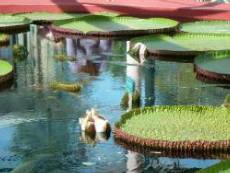|
at Adelaide Botanic Gardens Adelaide, SA Australia John Sandham, Collections Development Officer, Adelaide Botanic Gardens Images by Jeremy Prentice and Lyn Dargusch Click to enlarge |

|
From Adelaide Botanic Gardens "South Australian Premier Mike Rann officially opened the $4.3 million Amazon Waterlily Pavilion on 7 November 2007. The Pavilion, the third of Adelaide Botanic Garden's glasshouses, is an exquisite glass palace setting for a jewel of the natural world and indeed the Adelaide Botanic Garden's - Victoria amazonica. "The pavilion was constructed as part of the Garden's 150th Anniversary in 2007, as was the Schomburgk Pavilion and the SA Water Mediterranean Garden. " 'The completion of this impressive architectural inclusion to the heart of the Adelaide Botanic Garden marks a stunning job by South Australian designers and builders, which will help grow the Garden's 1.3 million visitors a year,' Mr. Rann said. "The Amazon Waterlily Pavilion replaces the Victoria House (1957) and Schomburgk Range glasshouses (1954). The original Victoria House was built in 1868 to house the Amazon Waterlily. The design of the new energy efficient glass house was inspired by the lily's giant leaves, and the original pond from Victoria House has been retained as the centre piece of the new pavilion." |
|
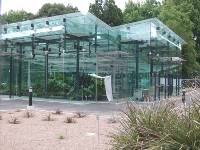
|
||
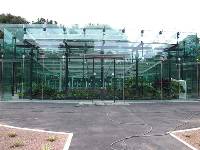
|
||
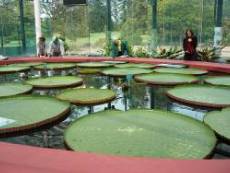
|
 |
|
 |
|
The Victoria House (1868) |
||
| Schomburgk had a great interest in tropical plants through his British Guiana collections. Many of these plants required glazed and heated environments, and Adelaide Botanic Garden was already well equipped for gardening under glass (see Section 3.3.4). With the development of the Victoria House in 1868, however, Schomburgk was able to realise the first of his ambitious plans for a series of impressive new horticultural buildings. The Victoria regia (now V. amazonica) or Giant Waterlily was associated with both Robert and Richard Schomburgk. In 1837 Robert had brought back from British Guiana a description of the plant and seed leading to its botanical classification. A number of attempts were made to grow it in England before a specimen flowered for the first time at Chatsworth in England in 1849. Francis had ambitions to grow the lily in Adelaide Botanic Garden from as early as 1856 and, after many attempts, his colleague Mueller had flowered the lily in Melbourne Botanic Gardens in 1867. Schomburgk and his Board were soon obtaining estimates for a new glasshouse that would enable its propagation. | ||
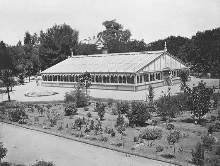 Image from the National Library of Australia |
The remarkable growth habits of this waterlily had inspired the idea of a special glasshouse known as a Victoria House to accommodate a plant which could produce leaves of 1.6 to 2.1 m in diameter. Adelaide's tank was 36 feet by 25 feet and 6 feet deep (10.9 m x 7.9 m x 1.8 m), making it larger than that of the Duke of Devonshire at Chatsworth in England. Three-inch (7.6 mm) pipes were laid at the bottom of the tank under pebbles and soil, with a small waterwheel to provide movement in the water. | |
| The venture was a huge success and the first flowering produced extraordinary public interest. Newspaper reports gave hour-by-hour descriptions of the opening of the flower buds. Some 30,000 visitors were recorded in the five-week period up to November 1868. Success in cultivation was a source of great pride to Schomburgk and his Board. The Victoria House helped to build up the prestige of Adelaide Botanic Garden and with it Schomburgk's own reputation. He was quick to point out that he was able to grow many other tropical plants in the Victoria House, including epiphytic and terrestrial orchids. |
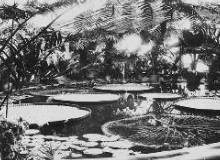 Image from Development of Adelaide Botanic Garden |
|
| Orchids-of great interest in the horticultural world of the time-were acquired from Kew, Java, and St Petersburg helping to bring the total of orchid species to 160, with a further 95 species being added in 1870. There was also a fine collection of plants with variegated leaves. | ||
